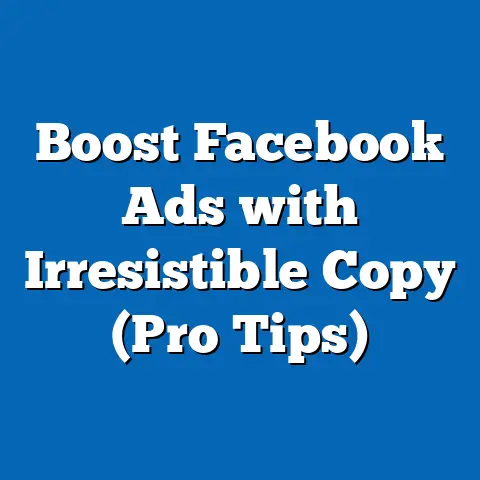Mastering Facebook Ads Interests (Unlocking Targeting Secrets)
As a research analyst with a passion for understanding demographic trends and digital behavior, my journey into the world of Facebook Ads began with a personal experiment nearly a decade ago. I was tasked with promoting a small family business online, armed with little more than a modest budget and a desire to connect with the right audience. Through trial and error, I discovered the power of interest-based targeting—a tool that transformed a struggling campaign into a modest success, driving engagement from precisely the people we wanted to reach.
This personal experience mirrors a broader generational shift in how businesses and individuals interact with technology, particularly in the realm of digital marketing. The rise of social media platforms like Facebook, now Meta, has redefined advertising, creating opportunities for hyper-specific targeting that previous generations of marketers could only dream of. This article delves into the intricacies of mastering Facebook Ads interests, exploring how this tool leverages demographic and behavioral data, its historical context within the evolution of digital advertising, and its profound societal implications for privacy, consumer behavior, and generational engagement.
Defining Facebook Ads Interests: The Core of Precision Targeting
At its essence, Facebook Ads interests refer to the categories of topics, activities, and behaviors that users express through their interactions on the platform. These interests are derived from a user’s likes, follows, group memberships, and even off-platform behavior tracked through partnerships and data integrations. For advertisers, this data forms the backbone of precision targeting, allowing campaigns to reach niche audiences based on specific hobbies, professional interests, or lifestyle preferences.
However, the effectiveness of interest targeting is not uniform across all demographics or generations. Younger users, such as Gen Z, often exhibit diverse and rapidly evolving interests, while older generations, like Baby Boomers, may have more stable but less digitally expressed preferences. Understanding these nuances is critical for advertisers aiming to unlock the full potential of this tool.
Historical Context: The Evolution of Digital Advertising and Generational Shifts
To appreciate the significance of Facebook Ads interests, we must first contextualize their emergence within the broader history of advertising and technology. In the mid-20th century, during the post-World War II economic boom, Baby Boomers (born 1946–1964) grew up with mass media advertising—think television commercials and print ads in magazines. These methods relied heavily on broad demographics, with little ability to personalize messages beyond basic regional or age-based segmentation.
The advent of the internet in the late 1990s and early 2000s, a period shaped by Generation X (born 1965–1980), introduced digital advertising through banner ads and early search engine marketing. Google’s AdWords, launched in 2000, marked a turning point by allowing advertisers to target based on search intent—a precursor to interest-based systems. However, it was the rise of social media, particularly Facebook’s launch in 2004, that revolutionized the landscape for Millennials (born 1981–1996) and beyond.
Facebook Ads, introduced in 2007, initially offered rudimentary targeting options. By 2012, as Gen Z (born 1997–2012) began engaging with the platform, Meta had refined its algorithms to incorporate detailed user interests, fueled by the explosion of data from mobile devices and app usage. This era also saw significant events like the 2013 rollout of Custom Audiences and the 2016 Cambridge Analytica scandal, which highlighted both the power and ethical dilemmas of data-driven targeting.
These historical milestones reflect generational differences in technology adoption and privacy attitudes. While Millennials embraced social media as a tool for self-expression, often sharing personal interests openly, Gen Z has grown up in a post-privacy scandal world, exhibiting greater caution about data sharing. Meanwhile, older generations have adapted to digital platforms at varying paces, with some embracing online communities and others remaining skeptical of data collection practices.
Key Characteristics of Facebook Ads Interests: A Tool for Connection and Controversy
Facebook Ads interests are characterized by their depth and adaptability, offering advertisers over 25,000 interest categories to choose from, ranging from broad topics like “technology” to hyper-specific ones like “vintage car restoration.” This granularity allows for campaigns that resonate deeply with target audiences, fostering engagement rates that often surpass traditional media. According to a 2022 study by Hootsuite, ads leveraging precise interest targeting can achieve click-through rates up to 2.5 times higher than non-targeted campaigns.
Yet, this tool is not without controversy. The same data that enables precision also raises concerns about privacy and manipulation, particularly across generations with differing views on digital ethics. For instance, a 2021 Pew Research Center survey found that 64% of Gen Z users worry about how their data is used in advertising, compared to only 48% of Baby Boomers, who may be less aware of or concerned about data tracking.
Moreover, the effectiveness of interest targeting varies by cultural and economic context. In wealthier markets with high internet penetration, such as North America and Western Europe, users generate abundant data for targeting. In contrast, in emerging markets, where internet access may be sporadic and user profiles less detailed, interest targeting can be less reliable. These disparities highlight the importance of understanding not just generational differences but also global socioeconomic factors.
Societal Implications: Privacy, Consumer Behavior, and Generational Dynamics
The societal impact of mastering Facebook Ads interests extends far beyond marketing metrics, touching on issues of privacy, consumer behavior, and intergenerational relationships. At the forefront is the privacy debate—an issue that has gained prominence following high-profile data breaches and regulatory responses like the European Union’s General Data Protection Regulation (GDPR) in 2018. For younger generations, who have grown up with social media, the trade-off between personalized ads and personal data often feels like an unavoidable reality, though many express discomfort with the extent of surveillance.
Consumer behavior, too, has been reshaped by interest-based advertising. Millennials, often characterized as value-driven consumers, respond well to ads aligned with their interests in sustainability or social causes, as evidenced by a 2020 Nielsen report showing 73% of this cohort prefer brands that reflect their values. In contrast, Gen Z tends to prioritize authenticity and peer influence, often engaging with ads shared or endorsed within their online communities. Older generations, while slower to adopt digital platforms, are increasingly targeted through interests like health, retirement planning, and family-oriented products, reflecting their life stage priorities.
The workplace and cultural spheres also feel the ripple effects of this advertising paradigm. Businesses, especially small and medium enterprises, have democratized access to sophisticated marketing tools, allowing them to compete with larger corporations by targeting niche interests. However, this also contributes to generational divides in media consumption—younger users may encounter ads on Instagram (owned by Meta), while older users see them on Facebook, reinforcing echo chambers and differing cultural touchpoints.
Technological Factors: The Engine Behind Interest Targeting
The success of Facebook Ads interests hinges on technological advancements in data collection, machine learning, and algorithmic processing. Meta’s algorithms analyze billions of data points daily, from page likes to time spent on specific content, to infer user interests with remarkable accuracy. The integration of artificial intelligence has further refined this process, enabling predictive targeting—anticipating interests before users explicitly express them.
For advertisers, tools like the Facebook Ads Manager and Audience Insights provide a window into these interests, offering data on audience size, overlap, and engagement potential. However, technological disparities across generations can skew results. Older users may have less robust digital footprints, leading to less accurate interest profiles, while younger users’ constant app-switching and privacy settings can create fragmented data.
Moreover, Meta’s shift away from third-party cookies, announced in 2021 in response to privacy concerns and Apple’s App Tracking Transparency framework, signals a potential evolution in interest targeting. Advertisers may need to rely more on first-party data and contextual targeting, a change that could disproportionately affect campaigns aimed at younger, privacy-conscious demographics.
Economic Influences: Cost, Accessibility, and Market Dynamics
Economically, Facebook Ads interests have leveled the playing field for advertisers by offering cost-effective targeting compared to traditional media. Small businesses, startups, and even individual creators can reach highly specific audiences for as little as $1 per day, a stark contrast to the thousands required for a single TV spot. A 2023 report by Statista noted that the average cost-per-click for interest-targeted ads is $0.97, making it accessible across economic brackets.
However, the economic impact varies by generation and market. Younger users, often with lower disposable income, may engage with ads but convert less frequently, while older generations, with greater purchasing power, can be more lucrative targets for high-ticket items. Additionally, in regions with lower ad saturation, interest targeting can yield higher returns due to less competition, whereas in oversaturated markets like the U.S., costs are rising as more advertisers vie for the same audiences.
Social and Cultural Dimensions: Bridging or Widening Generational Gaps?
Socially and culturally, interest-based targeting both connects and divides. On one hand, it allows brands to craft messages that resonate with specific subcultures or generational values—think Gen Z’s affinity for memes or Baby Boomers’ nostalgia-driven content. On the other hand, it risks reinforcing filter bubbles, where users are exposed only to content aligning with their existing interests, potentially deepening societal divides.
Across generations, cultural attitudes toward advertising also shape engagement. Millennials and Gen Z often view ads skeptically, seeking transparency and authenticity, while older generations may be more receptive to traditional sales pitches if they align with trusted interests. These dynamics underscore the need for advertisers to tailor not just the targeting but also the tone and content of their campaigns to reflect generational norms.
Nuances and Diversity Within Generational Responses
It’s critical to acknowledge that generational categories are not monolithic. Within Gen Z, for instance, urban teens may have vastly different interests and digital behaviors compared to their rural counterparts. Similarly, not all Baby Boomers are tech-averse; many have embraced social media for staying connected with family or pursuing hobbies, generating rich interest data for targeting.
Economic status, education, and cultural background further diversify responses to interest-based ads. A high-income Millennial may engage with luxury travel ads, while a working-class peer prioritizes budget-friendly options. Advertisers must navigate these nuances, using interest targeting as a starting point rather than a definitive label, to avoid alienating segments of their audience.
Qualitative and Quantitative Insights: What the Data Tells Us
Quantitatively, the efficacy of interest targeting is well-documented. Meta’s own 2022 reports indicate that campaigns using detailed interest targeting achieve a 37% higher return on ad spend compared to broad targeting. Engagement metrics, such as likes and shares, also spike when ads align with user interests, particularly for visually driven platforms like Instagram.
Qualitatively, user feedback reveals mixed emotions. Focus groups conducted by the Digital Marketing Institute in 2021 found that while many appreciate personalized ads—64% of Millennials cited relevance as a positive factor—there’s a pervasive unease about “being watched.” This sentiment is strongest among Gen Z, with 72% expressing a desire for more control over their data, highlighting a generational shift toward privacy advocacy.
Implications for Society, Culture, and the Workplace
The mastery of Facebook Ads interests carries profound implications for society and culture. It has accelerated the shift toward personalized experiences, influencing everything from shopping habits to political messaging. However, it also exacerbates concerns about data ethics and the potential for manipulation, as seen in past election interference scandals.
In the workplace, interest targeting empowers businesses to attract talent by aligning recruitment ads with candidates’ professional interests, but it also raises questions about discrimination if certain groups are inadvertently excluded. Culturally, it shapes generational narratives—ads targeting Gen Z often emphasize social justice, while those for Boomers may evoke nostalgia—potentially reinforcing stereotypes if not handled with care.
Forward-Looking Insights: The Future of Interest Targeting
Looking ahead, the future of Facebook Ads interests is both promising and uncertain. Meta’s pivot toward privacy-first models, including encrypted data handling and reduced reliance on third-party tracking, suggests a potential decline in the granularity of interest targeting. Advertisers may need to adapt by focusing on broader contextual signals or leveraging Meta’s first-party tools like Shops and Events.
Generational shifts will also play a role. As Gen Alpha (born 2013–present) enters the digital space, their behaviors—shaped by immersive technologies like augmented reality—may redefine how interests are expressed and captured. Meanwhile, aging populations will continue to grow as a target market, necessitating strategies that bridge digital and traditional touchpoints.
Regulatory landscapes will likely tighten further, with laws like GDPR inspiring similar frameworks globally. Advertisers must balance innovation with compliance, ensuring transparency to maintain trust across generations. While the specifics remain unclear, one certainty persists: mastering interest targeting will require agility, empathy, and a deep understanding of the evolving interplay between technology and human behavior.
Conclusion
Mastering Facebook Ads interests is both an art and a science, blending cutting-edge technology with a nuanced understanding of generational and societal dynamics. From its historical roots in the digital advertising revolution to its current role in shaping consumer behavior, this tool offers unparalleled opportunities for connection—yet demands careful navigation of ethical and cultural challenges. As we move into an era of heightened privacy awareness and technological change, the ability to unlock targeting secrets will hinge on adaptability and a commitment to understanding the diverse needs and values of each generation. While my personal journey with Facebook Ads began as a simple experiment, it reflects a broader narrative of how data, when wielded thoughtfully, can bridge gaps and build meaningful engagement in an increasingly complex world.






